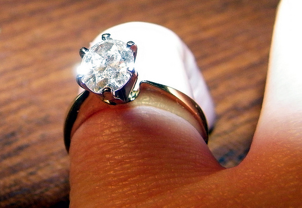What is a Diamond?
At its most basic level, a diamond is an extremely simple material – as it is made of pure carbon. That makes it the only gem made up of a single element. It is the hardest naturally occurring substance and the most valuable gemstone known to man.
But to most people, a diamond is much more than that. Universally regarded as a symbol of love and faithfulness, a diamond represents durability, quality and wealth – the gem itself reflecting the qualities we all seek in a loving relationship.
Diamonds come in different sizes, shapes and of course levels of quality. Quality is defined by the four C’s of diamonds: Cut, Clarity, Colour and Carat. Higher quality diamonds come with a hefty price tag and are often the reserve of celebrities – Richard Burton is said to have joked about a ring he purchased for Liz Taylor that, “This diamond has so many carats it’s almost a turnip.”
Diamonds are presented decoratively in various items of jewellery, but you can also buy loose diamonds, which can be set in whatever metal and piece of jewellery is desired.
Diamonds – a Potted History
The earliest diamonds were discovered in the land of Hind, or India as it is now known. The name diamond originates from the Sanskrit word, ’dyu,’ which means luminous being. The word diamond is also connected with the Greek word ‘adamas,’ or unconquerable. Greeks often applied this word to hard metals and stones.
The people of ancient times believed that the diamond had more power than any other stone, both physically and spiritually. Used in healing activities, diamonds were for instance used to help identify and treat poison.
The power of the diamond is considered to be particularly strong when connected to the left side of the body. This is believed to equate to the direction of the diamond’s growth (north), and through this connection, courage, harmony and love are enhanced.
Modern Diamonds
Modern is perhaps a moot point, but certainly since the 15th century, a diamond has been seen as a symbol of love. The Archduke Maximilian of Austria started the ball rolling in 1477 by giving a diamond engagement ring to his betrothed, Mary of Burgundy.
Billions of couples worldwide have since followed this trend – and even Carrie Bradshaw’s Mr. Big from Sex and the City eventually realised the error of his ways, and gave his lady a diamond – albeit a black one to match her soul!
A diamond is also the birthstone for the month of April, and is the symbol of a sixty (60) year wedding anniversary. Its connections with romance in the modern age are undeniable, and certainly a world away from its earlier linkages with warding off evil spirits.
Diamond Options
Diamonds are in essence a thing of beauty. But when it comes to putting our own stamp on a diamond, the job can be far from easy.
Diamonds can be incorporated into any item of jewellery you desire, from stunning necklaces, to brilliant bracelets, but the most popular choice is still a diamond ring. But how do you get the ring that you want?
Presenting Your Diamond
Many people feel frustrated that what is available is not quite what they had always dreamed of. Like a wedding gown, a diamond ring is something which has to be just right, and close enough won’t do.
This is where loose diamonds can provide a solution. Offering the flexibility to suit all styles and budgets, deciding to buy loose diamonds, whether from diamond importers or more likely diamond wholesalers, gives you the stones you crave, and the freedom to present them in whatever way you choose.
So, call on your creativity to create your stunning diamond centrepiece, as a symbol of your own brilliant and luminous love story.
